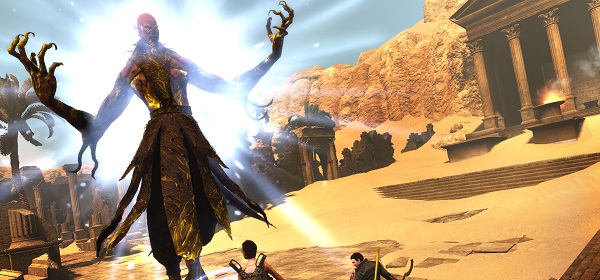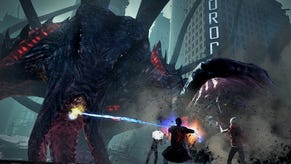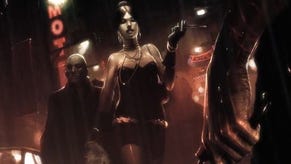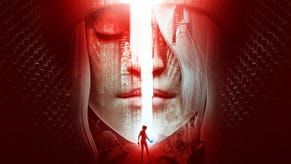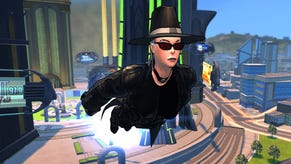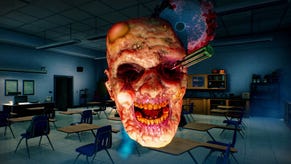Voices In The Shadows: The Secret World Interview
"Everything you’ve ever done in an MMO is selfish."
After spending some time with The Illuminati, I escaped from The Secret World to speak to lead designer Ragnar Tørnquist about overcoming the challenges inherent in building a story-based MMO. We talked about creating coherence in a vast and varied world, the confused and confusing role of the hero in an MMO, and how it's possible to reinvent and deconstruct a genre.
RPS: A big question to start with. It’s the second time I’ve seen the game and these segments seem even more character-based, bringing out more of the world and its huge number of plotlines. What about this story did you feel should be told in an MMO specifically?
Tørnquist: (laughs) I keep getting this question and it is a very valid question. This game was designed, on the story side even, as an MMO and that’s been extremely important and we’ve spent hour and hours, days and days, weeks and weeks…months and months, talking about exactly how to do a story in an MMO. There are different ways of doing it and we’re breaking new ground.
Obviously The Old Republic has its own approach to storytelling and it’s luckily very different from ours, which is great because we need variety. WOW has its style and everybody else has done their style of it, but what we’ve chosen to do is, first of all, to carry the theme in which the player is not the hero. The player is part of an army of heroes, one cog in a gigantic mechanism that churns and has been churning for thousands of years.
Of course, parts of the story are very character and personally focused, especially when you go into the cinematics and those parts of the game, but for the most part, the characters in the game acknowledge that you are just one of many, many, many heroes, and that you’re not necessarily trying to save the world. For the most part you’re doing things that are very selfish and when you sit down to play the whole game you’ll see that. It’s one of the key themes in the game.
What players are doing is entering these giant secret societies whose only intention is to keep everything under wraps and make sure there’s no widespread panic. They’re not really out to save individual people, they’re out to ensure that the status quo is maintained and that this great evil doesn’t rise and destroy the world that they want to keep to themselves.
The player is part of that and everything that you’ve ever done in an MMO is very selfish, it always has been. What are you doing? You’re out here, killing things to get loot and to make yourself better.
RPS: Parts of The Secret World seem like commentary almost.
Tørnquist: Yeah, it is.
RPS: With the Illuminati, they talk about games, they’re almost self aware. They almost break the fourth wall and it feels that there’s an element of that in the design.
Tørnquist: Exactly. And there are mission givers throughout the game, one in particular in New England. You haven’t seen him, his name is Sam Creed and he’s a writer who lives in a giant ivory tower, the lighthouse, and he’s someone who writes exactly the sort of stories that we’re telling and is now seeing them all come to life and he’s kind of commenting on what the player is doing in the game as well. That they’re just there to gain personal wealth and personal power, and accomplishing absolutely nothing.
RPS: Was that idea always there? When I said ‘why an MMO’, would one answer be ‘to deconstruct the whole idea’?
Tørnquist: Yeah, absolutely. I love playing MMOs and I’m not going to mention names but in some MMOs, where you do a quest for somebody in the village and you come back to the village and they have a parade for you because you’re the one who saved them and then right behind you there’s another guy! And he gets the same reception and you think, really? These guys are jerking me around.
RPS: The Illuminati woman, the evil…
Tørnquist: She’s not evil, she’s just…Kirsten Geary!
RPS: Yeah, Kirsten. There’s that whole thing with her where she gives you a quest and then shoos you away and says, “I’ve got another recruit coming, get out”. You don’t matter to her.
Tørnquist: Yeah, it’s that whole rat in a maze running around and around. But we’re not saying that what you do in the game is pointless, we’re saying that for the most part what you are doing as the character is pointless but the player is taken away from that at certain points and told that they have to make a choice.
At certain times it’s clear that it isn’t sustainable and that a great evil is rising and you have to make a choice. I don’t want to say too much about that because I’d spoil it, but the world in an MMO is unchanging, it’s static, and you have to address that. You can’t just ignore it You can’t just say that things reset every day, or every time somebody does a mission, so it’s really been key for us and it’s frustrated the hell out of the team and the designers trying to achieve that.
One of our rules is that the player is not allowed to kill any key characters or NPCs, or humans even, because we have story mechanics behind everything. There’s a reason the player character perishes and goes into the animus state and is able to be resurrected because they have this anima in them that allows them to step into the death world and back out again. But if you go and kill some of the locals, people on the street, in our fiction that person would be permanently dead.
RPS: There’s a line I noticed, “they have non-compete spells in place”, which again seems like a commentary on game, but also part of the narrative.
Tørnquist: Yeah, I think all of the writers are very keen on having that – not breaking the fourth wall but having the commentary on stories in MMO, while at the same time being a really good story. We’re not out there just to deconstruct stuff, we’re out there to tell a story. And I think for a lot of players they will never pick up on this stuff and that’s fine. They won’t care. They’ll just think they’re going out and doing cool stuff and at the end of the day they’re getting good rewards.
RPS: One of the other things was the deck system, which in a classless game seems like a way to help people to have a build.
Tørnquist: To become a class, yeah.
RPS: It almost feels as if you’ve gone for the classless, levelless structure, but then you put systems in place to help people and allow them to evolve past that when they’re ready to.
Tørnquist: It’s a good point. We don’t have levels, period, and we don’t have classes, period. But we do have the decks, for example, which is more direction than anything else. Me, as a player, I’m the kind of player who likes classes. I think it’s fantastic that we have a game without classes, I think it’s the right choice and I’ve been behind that the whole time, but I also like to have direction.
So I’m going to be using the decks when I play the game. I’m going to choose a character and know what kind of skills I want and the game will point me in that direction. But I can change at any point and that’s what fascinates me. I don’t mind having a class but I don’t like being locked into anything and this game opens that up.
The same goes for levels to. We don’t have levels at all but we do have ranks within your secret society and that’s much more to do with fiction than anything else. It’s a title, it’s a place within that organisation. But to me that’s an idea, I know I’m rank five so I know I’m progressing in the game and in the story.
You’re right, we start with the clean slate of saying we have no classes or levels, and then we introduced mechanics to make sure that people feel there’s direction, incentive and progression, and that’s really important too.
RPS: And it helps people to group together. I think one of the things when you do a dungeon is that you need the right people, so if you can turn to someone and say, ‘can you handle this job’?
Tørnquist: You can show someone your deck and share it with them.
RPS: Oh yeah, you can drag it across. The UI is impressive and the sharing of missions and decks is really helpful. The ingame web browser is new as well.
Tørnquist: In most games you wouldn’t have a need for it. If you’re playing in a fantasy world, you don’t need it. But in our game it makes perfect sense that it’s there because it’s tied into the gameplay as well.
RPS: It’s something that you would have in the world as well.
Tørnquist: The philosophy of our UI has always been to make it like watching an augmented reality on your phone and that’s what it should feel like. The player does get a phone at the beginning and then they experience everything in the story through that.
Again, it’s all about tying everything into the fiction and being very sure that we don’t break that immersion at any point.
RPS: You have these huge areas: Newport and The Scorched Desert. Do you worry that there could be a disconnect? That they are places with no in between?
Tørnquist: Yeah. That was always the challenge. I remember back when we started talking about the game in the first place, which we discussed last time we spoke, about originally having the player go to the airport and having the Indiana Jones red lines on the map idea. But that’s also isolating. So that’s the idea behind Agartha, to build a travel hub and to make the transition between areas in the world as smooth as possible.
It’s hard to get that impression when you’re sitting in our office playing isolated portions, but when I sit down and make a new character I do get a sense of walking into the tube in London or into the warehouse in New York, and that there is then a gradual progression toward Agartha and then in Agartha there’s a gradual progression out into the playfield.
So, I think it’s definitely the best we could have done with that but it will be a challenge. The longer loading times are the more fragmented it feels, so that’s something we’re working on. But hopefully people will always feel like they’re in the same world because it’s tight, the atmosphere and the soul of the game is so controlled. You always feel like it’s a continuous world and we connect you all the time back to your headquarters, back to what you’ve done before, everybody references everything.
But it is a challenge and it’s a really good point, but one that I hope we’ve solved.
RPS: And you can backtrack as well.
Tørnquist: Yeah.
RPS: There are so many missions in each area, so if I don’t want to do some of them right when I come across them I can go back and forth?
Tørnquist: Yeah, yeah, you can.
RPS: One of the things that you mentioned last time, which was interesting, was that you said the story will ‘pause’ at a certain point. Not end. It will pause. Obviously there’s room for expansion and that’s part of the process but the idea of a story without an ending, that’s something that can be difficult, if a story is always in transit.
Tørnquist: It’s important that people don’t feel the story is going to go forever and someday twenty years from now the game’s going to shut down and they won’t get a conclusion. If you play the game at launch you’re going to see everything that points to one particular thing, which will be post-launch, but it’s really evident where the game is heading at that point.
Once we get there it’s going to be really evident where the next step is. We have a break point then, where we can say the first act is now done and it can then go in various directions. And we’re always going to look at the playerbase and listen to people, but we’re going to stick to our overarching storyline and make sure there’s a sense of satisfaction.
I think at launch people will realise they got a lot of answers but a bunch of questions, and those answers will be incoming and those answers will pose more questions and then we’ll get to the end of that first act, and all of the signs are in place for you to figure out what that entire first act is. And that act break will be a time to say, ‘we know what’s going on’, and we can start a new story, or a new act of the story.
It’s really important to us not to have a continuous cliffhangery feel to it, but to feel that the story goes up and down. It has peaks and it has valleys. We’ve talked a lot about the story in MMOs and I think of that as a jigsaw puzzle. It’s not so much about pushing things forward, it’s about unearthing the past and piecing that together.
RPS: Is the worry not then – and I talk about ‘worry’ a lot…
Tørnquist: You’re a worried person, Adam!
RPS: I worry about everything! But is there a concern that people may be uncovering pieces, but in the MMO environment they may not feel like an important piece themselves?
Tørnquist: I totally understand and see that. It’s part of the challenge with the character not having a voice, becoming a blank state. But that was our intention. You’re going into this game at launch as a blank slate yourself, you know nothing about the world. They’ll be thinking, ‘what’s going on’, and they will be that silent observer.
So it makes sense that the player doesn’t say anything, they have nothing to add to this, they have no idea what’s going on but they are gaining more and more information. We actually talked about at one point when the game has been live for a while, we may give the player a voice, because at that point they will have something interesting to say. I like the player not speaking because I like to imagine my own character’s voice, but it’s something that we will definitely consider.
Everything you pick up in the world will make you feel like you’re gaining an understanding, you’re not necessarily an active part but you are becoming a walking library and I think that’s going to be extremely crucial as we go into content post-launch and see what happens with the storyline. But there are key moments in the game that we’re not revealing that have the player being strong participants in key events.
RPS: Thanks for your time.
The Secret World is out on June 19th. If you want more, I've previously nattered with Ragnar and two of the other lead designers.





